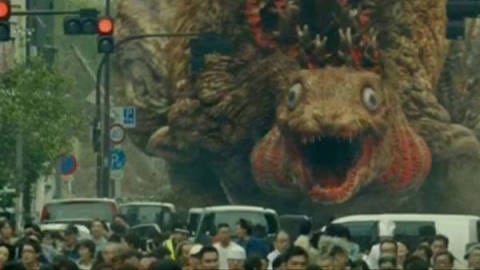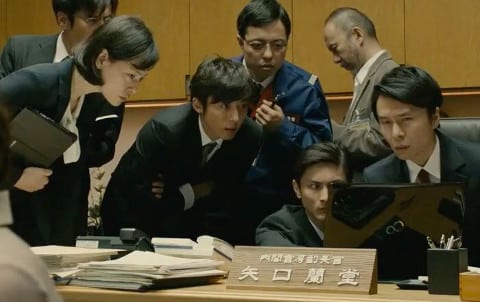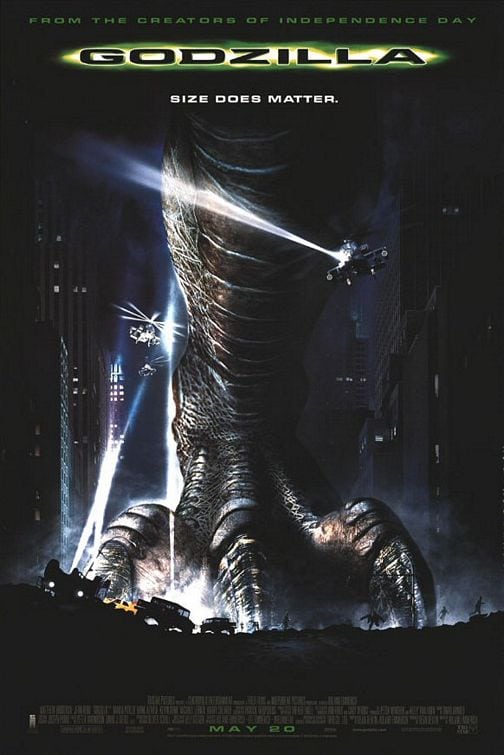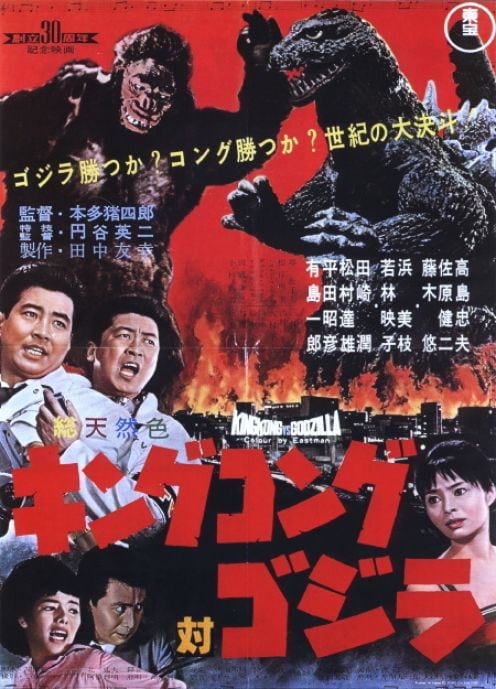Shin Godzilla (2016)
Directed by: Hideaki Anno, Shinji Higuchi
Written by: Hideaki Anno
Starring: Hiroki Hasegawa, Ren Ôsugi, Satomi Ishihara, Yutaka Takenouchi
Japan
IN SELECTED CINEMAS: 10th August
RUNNING TIME: 119 mins
REVIEWED BY: Dr Lenera, Official HCF Critic
The Japan Coast Guard investigates an abandoned yacht in Tokyo Bay, but their boat is destroyed and the Tokyo Bay Aqua-Line is flooded. Deputy Chief Cabinet Secretary Rando Yaguchi is convinced that the incident was caused by a living creature, something confirmed when news reports show a massive tail coming out of the ocean and a huge animal moves inland via river. Prime Minister Seiji Okouchi assures the public that the creature is unable to come onto land due to its weight, but he’s soon proved wrong and immense destruction and casualties result. The U.S. sends a special envoy, Kayoko Ann Patterson, who reveals that a disgraced, anti-nuclear zoology professor, Goro Maki, had been studying mutations caused by radioactive contamination and theorised the appearance of the creature, but the U.S. covered it up. The yacht abandoned in Tokyo Bay had belonged to Maki….
Like many Godzilla fans throughout the world, I’m still reeling from the death of Haruo Nakajima, the actor who wore the Godzilla suit for the first twelve films in the series, so I cannot help but still feel some sadness as I write my review for Shin Godzilla, the newest instalment, and a film which seems to have divided fans even more than 2014’s American reboot of Godzilla. Shin Godzilla is itself a reboot, and really the first fully fledged one to come from Toho. While the series has started afresh several times before, the existence of the events that were told in the original 1954 Godzilla was never called into question even if its sequels were ignored. However, this time Toho has opted to start all over again entirely, and not only that. They’ve also decided to make a Godzilla film that is not only quite different from the norm but is actually probably less of a conventional kaiju movie than the 2014 film. I remain of the opinion that that film, despite having some serious problems, was about as good an American Godzilla film as one could have a right to expect, and I have a hunch that its sequel will, to use that childish term, totally rock. With regard to Shin Godzilla, I had a nasty feeling that I wouldn’t be much keen on what was unfolding in front of me, and would have to regretfully give it a poor review. After all, when I reviewed all the earlier films a few years ago for this website, it would have been evident to many readers that I haven’t been overly keen on some of Toho’s more revisionist touches in the past.
However, several minutes into Shin Godzilla, and those fears begun to evaporate – though to be honest I cannot imagine any Godzila fan not getting excited when the first sounds that you hear are also the opening sounds from the 1954 Godzilla – those footsteps and then that roar – and it’s quite appropriate because this film is closest to that one – not in style but in spirit -than any others. Much as that film was unmistakeably an allegory of the dropping of nuclear and fire bombs on Japan, this one quite obviously refers to three recent disasters that took place in the country all in 2011, the Tohoku earthquake and tsunami as well as the Fukushima disaster that followed, when the earthquake disabled the power supply and cooling of three Fukushima Daiichi reactors, causing radioactive material to be spread far and wide. Also reminiscent of the satirical elements in King Kong Vs Godzilla and Mothra Vs Godzilla, though handled far more seriously, this film ruthlessly criticises the way these disasters were handled by the authorities, bureaucracy and red tape drastically reducing efficiency and costing countless lives. While all this obviously means far more to Japanese folk than people who are not Japanese, I think that most of us can still relate to some of this, us all seeming to exist in a world where the simplest things are made increasingly difficult by needless complexity and often downright incompetence.
But enough of all this – you want to know how well does it work as a film featuring a huge monsters that wrecks Japan. Actually, despite what you may have heard, it works rather well despite a few stumbles. The main criticism by dislikers seems to be the limited time that the star of the show has on screen. There were similar complaints levelled at the 2014 film. I didn’t think they were warranted in the case of that movie, and, while there are undoubtedly a few fustrating moments where destruction footage seems to be cut short, on the whole I didn’t find it to be much of a problem with this one either. I can think of two or three much older Godzilla films that contain less Godzilla footage even if one takes into account their shorter running times. Initially more of a worry to me was that Godzilla is now a CGI beast, albeit rendered through motion capture. Footage using a puppet was unfortunately abandoned, though it’s obvious that some model work is in the film – just check out some of those trains! It’s rather sad that, despite saying in the past that Godzilla will always be a person in a suit because it’s ‘cultural’, the Toho suits have decided that even in Japan viewers won’t accept ‘suitmation’ anymore. I think that the takeover of computer graphics in terms of special effects and the loss of many the old ways of doing things is very sad. Yet one has to regretfully move with the times and the CGI Godzilla, which has been given a texture to make it look like a latex suit, is, for the most part, pretty good. It’s not as good as the recent American one, but that one was quite phenomenal in its realism, plus Legendary Pictures of course had a far bigger budget to work with. Some of the destruction looks damn fine, though a few shoddy crumbling skyscrapers couldn’t help but give me nasty flashbacks to Man Of Steel.
Three paragraphs in and I haven’t even begun to go through the film, but then this is a new Godzilla picture and a Japanese one at that, while as this is a newer picture I’m not going to detail everything that happens. The investigation of the yacht, handled ‘found footage’ style, gets things off to a good start and the shot of what looks like blood [though it’s referred to as water] pouring into the aqua-line is startling despite the effect not being too great. The authorities debate what to do, and their answer to everything seems to be to hold another meeting and thereby delay matters further. The satire here is spot on, especially with the resistance of the temptation to make these people goofy – everything seems very believable. There’s much visual repetition but it’s clearly intentional. One thing that is a little annoying is the almost constant text introducing characters [some of whom are barely seen again] and location on the screen, often while subtitles are appearing at the bottom because people are speaking. Telling us who someone is and their job title does actually fit in with the overall theme of the film if you think about it, but do we really need to be told that people fleeing down an exit are on the “emergency evacuation slope”? There’s far less of this though as the film goes on. Now an important part of every Godzilla film is his first appearance and Shin Godzilla takes an unusual approach. Soon after shots of a tail, we make out his finned back amidst dust caused by his rampage, then, after a bit more ‘found footage’, our first view of him is on all fours [almost resembling a tadpole] and head-on as people flee in the foreground. It’s a good idea, but slightly weakened by the prominence of Godzilla’s lifeless, button-like eyes [almost as bad as those awful ping pong things in The Return Of Godzilla], though the eyes look better when Godzilla becomes bipedal and comes across as, I suppose, a cross between the 1954 version and the heavier creature of the later ‘Heisei’ Godzilla films from 1989 to 1996.
Still generally grey but also red in places like his incarnation in Godzilla Vs Destroyer, Godzilla destroys some of Tokyo, and the PM Seiji Okouchi orders a military attack, only to cancel it fearing more civilian casualties. While not perfect, he’s actually quite a noble figure who has to make some difficult decisions, but is surrounded by cabinet members who are more concerned with protecting their own positions than saving lives. Fortunately Deputy Chief Cabinet Secretary Rando Yaguchi puts together a team which works around the clock to study Godzilla and work out how to destroy him. It seems that a professor killed on the yacht at the beginning was researching some contaminated nuclear waste. Meanwhile the U.S., which due to World War 2 has certain rights over Japan, gets involved and wants to use nuclear weapons on the creature. The main female character is “special envoy” Kayoko Ann Patterson, described as “a mixture of talent, pedicree and coattails”, who rather ludicrously wants to become the President of America despite being still essentially Japanese. One of the many unusual things in this film is the lack of ‘ordinary’ characters who get caught up in the action and often end up playing a large part in it. Apparently there were some in the original script but co-director and screenwriter Hideaki Anno decided to remove them. I think it was a good decision as it makes the film more unique, plus it would have been even longer than it is, though some may disagree.
The highpoint of Shin Godzilla is when, after an hour, the King of the Monsters finally uses his ray. I’m not going to describe the moment in detail, but it is a moment which for me belongs up there with Godzilla’s most iconic scenes. It’s awe-inspiring and you almost feel like cheering, until after a few seconds you become aware of the sheer scale of the destruction that’s being caused [and it really is immense and makes up for the slightly limited rampages earlier] and the huge number of the people obviously being killed, and the scene then becomes really horrifying and scary. It’s one of several clever bits in the film which try to get us to re-assess what we are seeing and even why we love Godzilla in the first place. The piece from the score here, a haunting chorale work, works brilliantly too. After this the film can only drop a little in quality and impact, and truth be told the pacing, which up to now has been surprisingly swift despite all the chatter, does slow down a bit more than necessary – though you could say that about the 1954 one too. I do think that three meetings between differing pairs of characters following virtually on from each other is overdoing it, while the scientific gooblygook could have done with some simplication so us average Joes could understand all of it. But the climactic attempt to destroy Godzilla, something which is sometimes disappointing in these films, is a genuinely exciting finale and ends in as perfect a way to end a Godzilla film as one can think of.
Shin Godzilla is credited to two directors: Neon Evangelion Genesis’s Hideaki Anno, and Shinji Higuchi, the latter chiefly dealing with the special effects scenes. Their work combines seamlessly. There’s some fine use of aerial shots to provide perspective, some of them quite scary in their implication, and only a couple of bits which rapidly cut between various characters voicing their opinions out loud seem rather silly. Characterisation isn’t actually too strong in a film where the people seem to exist mostly to prove whatever points the screenwriter is making, but Ren Ôsugi does his best to give the PM some depth and Hiroki Hasegawa is fine as Yaguchi. Unfortunately I have to say that Satomi Ishihara as Patterson may be one of the prettiest leading ladies in the series for some time but seems to constantly struggle in her role, especially when she has to alternate between speaking Japanese and English. The score for the film is rather uneven, consisting largely of different variations of Shiro Sagisu’s theme from Neon Evangelion Genesis and some Akira Ifukube tracks from older Toho films. Individually the music usually works – the use of the rousing Battle In Outer Space march during the climax really ramps up the excitement – but the score lacks cohesion as a whole. This does sometimes seem to be a flaw with Godzilla soundtracks though. Ifukube lovers are treated to a few more classic tracks during the end credits.
Yet overall Shin Godzilla must be judged an artistic success and something of a gamble which has paid off as it’s the most commercially successful Godzilla film in Japan for some time. Yes, it’s easy to sympathise with kaiju fans who want tons of monster action and some of that good old Godzilla movie silliness, the latter certainly being one of the things that me fall in love with these films as a kid. This movie is very dialogue heavy. However, one must admire Toho and the filmmakers for choosing to not rehash stuff we’ve seen over and over again [even I got bored with the way they kept bringing back the same old monsters in the last series]. And it’s not as if there isn’t much cool stuff in the film, and that the film doesn’t pay much homage to the past. Take the incredibly cool way Godzilla’s ray starts up as gas, lights up into a jet stream of fire, and then concentrates into a beam, while we hear a certain sound effect that we haven’t heard in a Godzilla film for a very long time. Yes, humour is largely missing, though there are little things for fans ‘in the know’ to chuckle at like the alternate explanation of how Godzilla got his name. Shin Godzilla also seems to try harder than many of the Godzilla films to make the Big G as relevant and fresh as he first seemed in his first cinematic outing. And in doing so, its makers truly honour the memory of Ishiro Honda and the other creators of the 1954 classic including, yes, Haruo Nakajima. The only really sad thing is that, due to frankly ridiculous fears that audiences will become confused by two different Godzilla franchises, Toho isn’t allowed to make another Godzilla film until 2020, as, for the first time in ages, I’m genuinely excited to see where they take the series next.
Rating: 









UPDATED UK CINEMA SITE LIST:
Aberdeen Cineworld, Basingstoke Vue, Bath Little Theatre Picturehouse, Belfast Odeon, Belfast Odyssey, Birmingham Empire, Birmingham Cineworld, Birmingham Broadway Plaza Odeon, Birmingham Electric Picturehouse, Birmingham Mockingbird, Bluewater Showcase, Bournemouth Odeon, Bradford Picturehouse, Brighton Odeon, Brighton Picturehouse, Bristol CDL Showcase, Cambridge Picturehouse, Cambridge Vue, Cardiff Showcase, Cardiff Tramshed, Clydebank Empire, Colchester Odeon, Coventry Showcase, Derby Showcase, Derby Quad, Dublin Movies@, Dublin Cineworld, Dublin Lighthouse, Dudley Showcase, Dundrum Movies@, Edinburgh Cineworld, Edinburgh Cameo, Exeter Picturehouse, Exeter Vue, Exeter Phoenix, Gateshead Vue, Glasgow Showcase, Glasgow Renfrew Street Cineworld, Guildford Odeon, Ipswich Empire, Leeds Showcase, Leicester Showcase, Leicester Phoenix, Liverpool Showcase, Liverpool FACT Picturehouse, Liverpool One Odeon, London Hackney Picturehouse, London Picturehouse Central, London Brixton Ritzy Picturehouse, London Panton Street Odeon, London Prince Charles, London Westfield Stratford Vue, London Genesis Mile End, London Newham Showcase, London Stratford Picturehouse, London Camden Odeon, London Clapham Picturehouse, London Crouch End Picturehouse, London Finchley Road Vue, London Holloway Odeon, London Islington Vue, London Wood Green Vue, London Kingston Odeon, London Croydon Grants Vue, London Greenwich Picturehouse, London Greenwich Odeon, London Wandsworth Cineworld, London Wimbledon Odeon, London Westfield Vue,Manchester Showcase, Manchester Printworks Vue, Metrocentre Odeon, Milton Keynes Stadium Odeon, Northampton Vue, Norwich Picturehouse, Norwich Vue, Nottingham Showcase, Oxford Vue, Paisley Showcase, Peterborough Showcase, Plymouth Vue, Portsmouth Vue, Reading Showcase, Sheffield Cineworld, Sheffield Showroom, Southampton Picturehouse, Southampton Showcase, Southend Odeon, Stratford upon Avon Picturehouse, Sunderland Empire, Swansea Vue, Swindon Empire, Teesside Showcase, Walsall Showcase, Watford Vue, Wigan Empire, Worthing Connaught, York Picturehouse, York Vue.









Be the first to comment